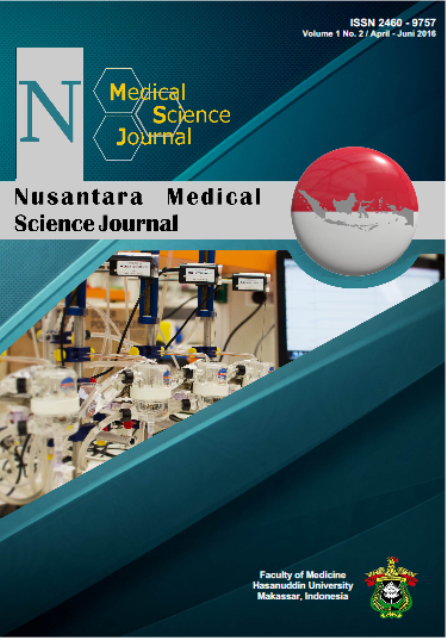THE ASSOCIATION OF POLYMORPHISM PROMOTER VEGF PROMOTER GENE POLYMORPHISM AND VEGF SERUM LEVEL WITH THE TYPE OF AGE-RELATED MACULAR DEGENERATION
DOI:
https://doi.org/10.20956/nmsj.v1i2.2211Abstract
ABSTRACT
Introduction: One of the potential genetic links to Age-related macular degeneration (AMD) is vascular endothelial growth factor (VEGF). The aim of this study was to investigate the association of polymorphism promoter VEGF gene and VEGF serum level with the type of AMD. Methods: Genomic DNA was extracted from peripheral blood of 66 samples, consist of wet and dry AMD, and age-matched controls. DNA was subjected to polymerase chain reaction amplification at the position -460 coupled with the restriction fragment length polymorphism. VEGF serum level was measured by Enzyme-linked Immunosorbent Assay. Results: The polymorphism promoter VEGF gene demonstrated significant association with the type of AMD (p=0.004, OR=3.1 95% CI 1.1-8.6) and the risk for increasing VEGF serum level (p=0.011, OR=3.2 95% CI 1.18.9). Despite there was no significant association between dry and wet AMD with VEGF serum level (p=0.081), but this study revealed significant increased of VEGF serum level in AMD patients, compared to those in control’s serum (p<0.001). Finally, there was coassociation between polymorphism and VEGF level with the type of AMD (p<0.001). Conclusion: This study reveals the significant association between promoter VEGF gene polymorphism and VEGF serum level with the type of AMD of Indonesian patients. Keywords: AMD, VEGF gene polymorphism; VEGF serum level.
References
See JLS, Wong TY and Yeo KT. Trends in the pattern of blindness and major ocular diseases in Singapore and Asia. Annals Academy of Medicine. 1998; 27:540- 546
Regillo C, Holekamp N, Johnson MW, et al. Retina and Vitreous, Basic and Clinical Science Course, Sec. 12. American Academy of Ophthalmology. 2008.
Nowak JZ. Age-related macular degeneration (AMD): pathogenesis and therapy. Pharmacological Reports. 2006. 58:353-363
Wong TY, Klein R, Sun C, et al. Agerelated macular degeneration and risk for stroke. Annals of Internal Medicine. 2006. 145:98-106
Hughes AE, Orr N, Patterson C, Esfandiary H, et al. Neovascular agerelated macular degeneration risk based on CFH, LOC387715/HTRA1, and smoking. PLoS Medicine. 2007. 4:1993-2000
Tuo J, Ross RJ, Reed GF, et al. The HtrA1 promoter polymorphism, smoking, and age-related macular degeneration in multiple case-control samples. Ophthalmology. 2008. 115:1891-1898
Seddon JM. Multivitamin-multimineral supplements and eye disease: agerelated macular degeneration and cataract. Am J Clin Nutr. 2007. 85:304-307
Ishida BY, Duncan KG, Bailey KR, et al. High density lipoprotein mediated lipid efflux from retinal pigment epithelial cells in culture. Br J Ophthalmol. 2006. 90:616-620
Scholl HPN, Fleckenstein M, Issa PC, et al. An update on the genetics of age-related macular degeneration. Molecular Vision. 2007. 13:196-205
De Almeida LNF, Carolino RM, Sperandio DC, et al. The role of molecular genetic factors in agerelated macular degeneration. Arq Bras Oftalmol. 2009. 72:567-572
Fang AM, Lee AY, Kulkarni M, et al. Polymorphisms in the VEGFA and VEGFR-2 genes and neovascular age-related macular degeneration. Molecular Vision. 2009. 15:2710-2719
Wang JJ, Mitchell P and Klein R. Epidemiology of age-related macular degeneration early in the 21st Century, In: Retinal Degenerations: Biology, Diagnostics, and Therapeutics. New Jersey: Human Press Inc. 2007. 23-59
Vannay A, Dunai G, Bánász I, et al. Association of genetic polymorphisms of vascular endothelial growth factor and risk for proliferative retinopathy of prematurity. Pediatr Res. 2005. 57(3):396-398.
Churchill AJ, Carter JG, Lovell HC, et al. VEGF polymorphisms are associated with neovascular agerelated macular degeneration. Human Molecular Genetics. 2006. 15:2955-2961
Szaflik JP, Blasiak J, Krzyanowska A, et al. Distribution of the C-460T polymorphism of the vascular endothelial growth factor gene in age-related macular degeneration. Klin Oczna. 2009. 111; 125-127
Papis JK, Zaras M, Krzyzanowska, et al. Association between vascular endothelial growth factor gene polymorphisms and age-related macular degeneration in a Polish population. Exp Mol Pathol. 2009. 87; 234-238
Kwak N, Okamoto N, Wood JM, and Campochiaro PA. VEGF is major stimulator model of choroidal neovascularization. Invest. Ophthalmol. Vis. Sci. 2000. 41:3158-3164
Tschirch E, Weber B, Koehne P, et al. Vascular endothelial growth factor as marker for tissue hypoxia and transfusion need in anemic infants: A prospective clinical study. Pediatrics. 2009. 123:784-790
Ozturk BT, Bozkurt B, Kerimoglu H, et al. Effect of serum cytokines and VEGF levels on diabetic retinopathy and macular thickness. Molecular Vision. 2009. 15; 1906-1914
Tsai DC, Charng MJ, Lee FL, et al. Different plasma levels of vascular endothelial growth factor and nitric oxide between patients with choroidal and retinal neovascularization. Ophthalmologica. 2006. 2220 (4): 246-251.









